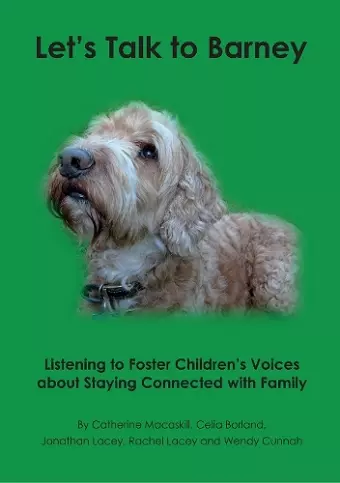Let's Talk to Barney
Listening to Foster Children's Voices About Staying Connected with Family
Catherine Macaskill author Wendy Cunnah author Jonathan Lacey author Rachel Lacey author Celia Borland author
Format:Paperback
Publisher:Free Association Books
Published:30th Sep '24
Should be back in stock very soon

Listening to children is a vital aspect of social work practice. 'Let's talk to Barney; Listening to foster children's voices about staying connected with family' is written in a child friendly manner. It is an activity book, suitable for professionals to use with foster children in the age range 5-10 years. It is the type of book which encourages professionals to engage in an interactive manner with foster children. Its primary aim is to let the voices of foster children be heard in relation to how they feel about maintaining a relationship with different members of their birth family. It focuses on the story of a dog.The material obtained by social workers through using this tool can then be used in contact planning and when reviewing contact plans.
In 2022 Coram Voice published Staying Connected , a report on the views of young people in care about their contact with their families. Fifty percent of those surveyed did not feel involved in decisions social workers made about their lives, and half of the comments about involvement focused on contact arrangements, commenting on arrangements being inflexible and not changing as their family's circumstances changed. Let's Talk to Barney is a resource for those wanting to know more about the views of children in foster care about the time they spend with members of their own families.The book introduces children to a dog who, like them, is cared for as part of a foster family. The book has pictures of Barney as a puppy, and his voice is used to tell us about himself, the things he enjoys, about living with his foster family and, later, about his separation from his siblings and mother. Barney's story fades out as the focus shifts via worksheets to the story of the child who the book is being used with. There is a family tree, and the young person is encouraged to use traffic lights to think about, discuss and record their views on contact. The book also encourages thought and discussion about different types of contact.There are appealing photographs, and the text of the book is clear and simple. My immediate thought was that the book would appeal most to a slightly younger age range, but the simplicity of the story and the worksheets would make it quite possible to use this or a similar story with children across a wide age range - and potentially adapt the story / worksheets for children who were interested in different things.Overall, this is a high-quality and appealing resource which has been thoughtfully put together. It would be a useful read for anyone wanting to discuss family contact with a child. The principles underpinning the story, as well as the book itself, will be a useful resource for anyone considering direct work with children in foster homes.Robert Bradshaw, Operations Director, Aidhour, and Head of Governance, Five Rivers Childcare
Let's Talk to Barney has been a delight to review. My first sight of Barney was on the front cover of this interactive workbook. My fingers itched to stroke him, cuddle him and tickle the fur behind his ears."Hello!" he greeted me on page 1. "My name is Barney, and I am an apricot cockapoo."I was hooked!***Over the pages that follow: Barney records his memories of his first family, his feelings about having to leave them and his uncertainty about whether he will see them again. He shares "who's who" in his foster family, the things he likes about living with them and what sometimes makes him feel fearful or sad. Finally, he invites his young readers to think about which of their birth relatives they would like to stay in contact with, how often and whether face-to-face or indirectly.***A special feature of this workbook is that Barney "goes first" in sharing his memories and feelings before he invites his young readers to do the same, with phrases such as "Barney asks if ...", "Barney wonders whether ...", and "Can you..." Many of the pages are laid out for the children's contributions - e.g. borders for a photo and drawings, family tree outlines, tick-boxes above cartoons of named emotions, plus "thought bubbles" to record their memories, feelings and wishes for the future.***Towards the end of the workbook are the following words: "Barney knows it is sometimes difficult talking about people in your family. Thank you for telling me about yours." I have no hesitation in recommending Let's Talk to Barney to social workers tasked with ascertaining the wishes of fostered children about future contact with their birth relatives.Caroline Hesslegrave, Sessional Adoption Consultant with Coram IAC
Let’s Talk to Barney is a beautifully constructed interactive story book for children in foster care. It is clear that the authors have a deep understanding of how children can, through creative interaction, be helped to stay connected with their families and be helped to make sense their fostering status and experiences. With Barney the Cockerpoo being central to the story and sharing his own experience of mixed heritage, birth family and foster family, the story is highly engaging and relatable and even as an adult I felt moved and encouraged to think about and share my own family history. Making sense of complex feelings and emotion is often difficult for children in foster care, and again the elements of this book relating to feelings felt well thought through as did the traffic light approach to informed decision making. I think this book will be a valuable addition to the tool kit of many foster carers and social workers. Satwinder Sandhu, CEO Consortium of Voluntary Agencies (CVAA) UK
ISBN: 9781911383949
Dimensions: unknown
Weight: unknown